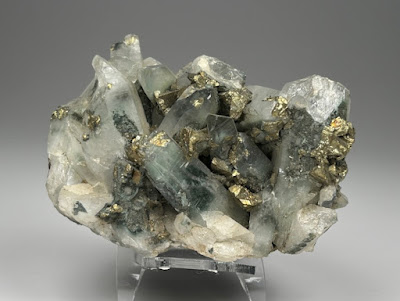明治期の鉱物標本 Meiji-Era Mineral Specimens
東京都内の古道具店にて、明治時代のラベルを伴う鉱物標本群を手に入れた。以下、産地がある程度確からしいと考えられる標本のいくつかを紹介する。
I purchased a group of mineral specimens and labels that seemed to be made in the Meiji era (beginning of the 20th century) at a junk shop. Shown below are some of the specimens of which the locality is less uncertain.
院内鉱山の含マンガン方解石 Manganese-bearing Calcite from Innai Mine
Innai Mine, Yuzawa City, Akita Prefecture, Japan
Size: 80 × 53 × 40 mm, Weight: 154 g
手に入れた標本は50点ほどあったが、この標本は唯一産地が確定できるもの。ラベルには Rhodonite (バラ輝石)とあったが、どうみても含マンガン方解石か菱マンガン鉱だろう。紫外線長波で明瞭に赤く蛍光する。塊状の標本だが、一部結晶面が出ていて、サイズはなかなかのものである。
Out of over fifty specimens I obtained, this is the only piece of which the locality is sure. The old label says it is rhodonite, but I think it is rhodochrosite or manganese-bearing calcite. It turns to red under a UV light. Crystal faces appear in part, and the size is relatively large .
院内鉱山は江戸期から明治にかけて盛んに掘られた、本邦有数の銀山である。脈石には石英の他、多量のマンガン方解石やバラ輝石がみられた(秋田県鉱山誌、1968年)。この標本にも黒っぽい金属鉱物が少量付着していて、多少の銀鉱物を伴っているのではないかとおもわれる。
The Innai mine was one of the most important silver mines in Japan, producing ores for a long time from the Edo to Meiji periods. Gangue minerals were quartz, maganocalclite, and rhodonite. Some of the black minerals found in this specimen will be silver sulfides.
孔雀石 Malachite
Arakawa Mine, Daisen City, Akita Prefecture, Japan?
Size: 96 × 44 × 30 mm, Weight: 122 g
典型的な銅鉱床酸化帯の標本で、緑色針状の孔雀石が多数みられる。古道具店で「発見」したときには、すでに標本とラベルとがバラバラになっており、この標本に限らず産地は定かでない。しかし「荒川」の文字が判読できるラベル(末尾の写真参照)があったことから、これは秋田県旧協和町の荒川鉱山産の標本ではないかと推測する。日本国内では、このようなリッチな銅の二次鉱物の集合体はすでに絶産して久しい。明治期の鉱産資源が豊かだった頃の標本で、貴重な歴史的遺物といえよう。
※ 当初ブロシャン銅鉱だとおもっていたが、希塩酸で溶けたので孔雀石と判断した。
This must be a copper ore from an oxidation zone, in which numerous green acicular crystals of malachite can be seen. When I made this purchase, the labels had already been separated from the minerals. Though the locality is basically unknown, I think this copper ore was collected in the Arakawa mine, Akita, because there was a label in which the word of "Arakawa" existed. In any case, this is a precious old-time specimen that was produced in the era when Japanese mining industry was most active.
水晶と黄銅鉱 Quartz and Chalcopyrite
Arakawa Mine, Daisen City, Akita Prefecture, Japan?
Size: 85 × 62 × 40 mm, Weight: 215 g
これも産地は定かでないが、前掲の孔雀石と同様、荒川鉱山産の標本ではないかと想像する。緑泥石を内包していると考えられる緑水晶と、かなりのサイズの黄銅鉱とが共生する。黄銅鉱には耳付き双晶がみられ、東日本日本海側の産物であることを示唆する。
The locality is unknown, but I guess this was also collected in the Arakawa mine. Golden chalcopyrite crystals are sprinkled over a quartz forest. Some of the quartz become greenish probably because of inclusion of chlorite. Some of the chalcopyrite crystals form a twin with ears that is distinctive in the Japan-sea side of the Eastern Japan.
方解石 Calcite
Yokomabu Vein, Ashio Mine, Nikko City, Tochigi Prefecture, Japan?
Size: 98 × 68 × 28 mm, Weight: 178 g
方解石と題するラベルは5枚あり、3枚は足尾鉱山産、2枚は岩手県の水沢鉱山産だった。実際、方解石をともなう標本はいくつかあったが、これはなかでももっとも立派なもので、薄板状の結晶が多数平行連晶している。足尾、水沢以外の産地の可能性も否定できないが、雰囲気的に足尾の方解石ではないかと想像する。
There were five labels entitled "Calcite", three of which being from the Ashio mine and the remaining the Mizusawa mine, Iwate Prefecture. This calcite specimen was most gorgeous, showing parallel growth of flattened crystals. I suppose the atmosphere is close to Ashio calcite, though possibility remains that it was from Mizusawa or other sites.
モリブデン・蒼鉛鉱物と灰重石 Molybdenum and Bismuth-bearing Minerals and Scheelite
Yokozuru Mine, San-no-take, Saidosho, Kawara Town, Fukuoka Prefecture, Japan?
Size: 45 × 38 × 34 mm, Weight: 96 g
Yokozuru Mine, San-no-take, Saidosho, Kawara Town, Fukuoka Prefecture, Japan?
Size: 60 × 45 × 23 mm, Weight: 76 g
三ノ岳横鶴鉱山産の輝蒼鉛鉱のラベル1枚と、同産地の輝水鉛鉱のラベルが1枚あった。これらはそれに対応する標本とおもわれる。横鶴鉱山の鉱床は、花崗岩と石灰岩との接触部に胚胎するスカルン型の高温交代鉱床であり、輝蒼鉛鉱、自然蒼鉛、磁鉄鉱、磁硫鉄鉱、黄銅鉱、黄鉄鉱、硫砒鉄鉱、灰重石などがみられた(日本鉱産誌 B 1-a、地質調査所、1955年)。採銅所という地名にもなっている歴史ある鉱産地で、とくにビスマス鉱物の古典的産地として知られる。1つ目の標本にはかなりリッチに銀黒色の金属鉱物が付着している。わたしの肉眼鑑定スキルでは鉱物種を断定することはできないが、輝水鉛鉱か、ビスマスを含む鉱物(輝蒼鉛鉱か硫テルル蒼鉛鉱か)と想像する。2つ目の標本にはかなりの灰重石が含まれており、紫外線短波で青白色に光る。少量みられる黒色部はやはりビスマスかモリブデンの硫化鉱物だろう。
There were two labels in which the locality was San-no-take Yokozuru, and the titles were bismuthinite and molybdenite. The Yokozuru mine had a skarn-type deposit, producing bismuthinite, native bismuth, magnetite, pyrrhotite, chalcopyrite, pyrite, arsenopyrite, scheelite, and so on, according to a literature. The first specimen richly bears black metal sulfides, but the mineral species is unknown because of my poor ability. The fluorescence under a short-wave UV light indicates a considerable amount of scheelite is included in the second specimen. The black part will be some sulfide of bismuth or molybdenum.
以上の他にも、産地が確からしいものとしては、長さ 3 cm の宮城県雨塚山の紫水晶、長さ 5.5 cm の愛媛県市ノ川鉱山産とおもわれる輝安鉱、尾平の斧石、足尾の菫青石、山梨県産とおもわれる水晶ポイント数個、そして佐渡相川産の金銀鉱石などがあった。
古道具店の主人いわく、汚損したラベルは捨ててしまった、とのこと。残されたラベルから推測するに、大部分は、東京帝国大学地質学教室の関係者(学生?)が、明治37年から38年(1904〜1905年)にかけて採集もしくは取得したものである。古道具店の主人によれば、その収集家の親族の方が十数年前に手放したという。主人の言い値はわたしの想像の2倍近かったが、このまま離散してしまうのはもったいない気がして、なにか使命感みたいなものに導かれて一括して購入した。
Other specimens of which I could specify the locality are: 3-cm long amethyst from Amezuka-yama, Miyagi, 5.5-cm long stibnite from the Ichinokawa mine, Ehime, axinite from Obira, cordierite from Ashio, rock crystals from Yamanashi, and gold-silver ore from Aikawa, Sado. The locality of most of the specimens is unknown. The shop owner said some of the labels had been abandoned because of bad condition. I guess from the existing labels that these minerals were collected or acquired by a student of the Imperial University of Tokyo in 1904 to 1905. The asking price was close to twice of mine, but I finally purchased all of the specimens and labels, guided by a kind of sense of responsibility.
付属したラベルのいくつか Some labels
A label of Geological Institute, Imperial University, Tokyo, in which the word "Arakawa" can be read. The title is unknown. It seems to begin with "Qu...", so it might be quartz. The date is May 14th, 1905.
Calcite from the Ashio Yokomabu vein. The date is March 29th, 1905.
The labels of molybdenite and bismuthinite from the Yokozuru mine. Both seem to be given by Katayama, who is probably different from a famous Japanese mineralogist, Katayama Nobuo.
補足
和田維四郎の「日本鉱物誌」の初版が出版されたのが明治37年(1904年)だから、まさにその当時の標本群である。学生が、本の内容に導かれて、こうした鉱物を収集したのかもしれない。
「日本鉱物誌」の初版にも自然蒼鉛や輝蒼鉛鉱の産地として三ノ岳があげられている。なおその後の分析により、三ノ岳産で当初自然蒼鉛や輝蒼鉛鉱(bismuthinite; Bi2S3)とおもわれていたものの一部は、硫テルル蒼鉛鉱(tetradymite; Bi2Te2S)を誤認したものであることがわかった(加藤昭・桜井欽一、鉱物学雑誌 5巻 5号 p.324、1962年)。











